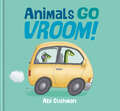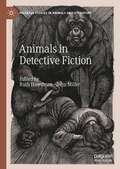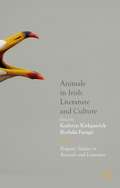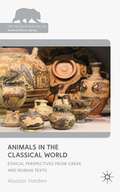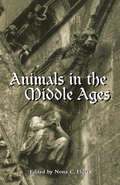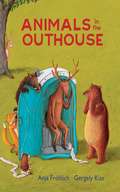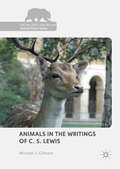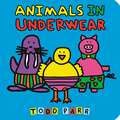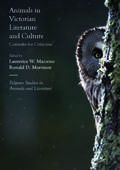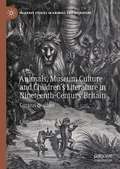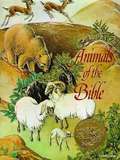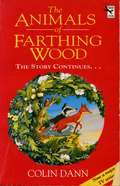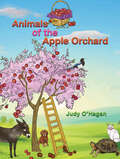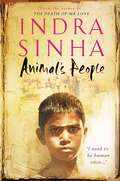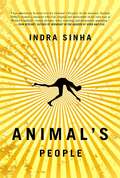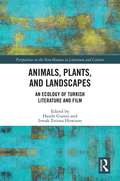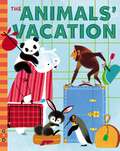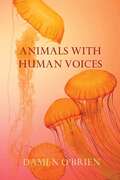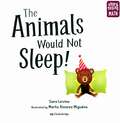- Table View
- List View
Animals Everywhere! (Thomas & Friends)
by Richard Courtney W. AwdryThomas rolls to the rescue after some mischievous monkeys let the animals loose from a visiting circus. Boys ages 3 to 7 will love this early reader featuring their favorite Thomas & Friends engines.
Animals Go Vroom!
by Abi CushmanWith a nod to Richard Scarry, this inventive picture book surprises readers with every turn of the page!Hiss! Screech! Roar! It's a noisy day in Bumperville! But are the sounds what you think they are? That Honk! must surely be a goose. But turn the page and it's the taxi that a goose is driving! Using cleverly placed die-cuts, this inventive book hints at what is making the sound, but with each turn of the page, it's an eye-opening surprise and part of an unfolding story that is part guessing game and part giggle-inducing caper. Abi Cushman is the master of surprise and silliness in this absolutely delightful picture book.
Animals in Detective Fiction (Palgrave Studies in Animals and Literature)
by Ruth Hawthorn John MillerThis book explores the vast array of animals that populate detective fiction. If the genre begins, as is widely supposed, with Edgar Allan Poe’s “Murders in the Rue Morgue” (1841), then detective fiction’s very first culprit is an animal. Animals, moreover, consistently appear as victims, clues, and companions, while the abstract conception of animality is closely tied to the idea of criminality. Although it is often described as an essentially conservative form, detective fiction can unsettle the binary of human and animal to intersect with developing concerns in animal studies: animal agency, the ethical complexities of human/animal interaction, the politics and literary aesthetics of violence, and animal metaphor. Gathering its 14 essays into sections on ontologies, ethics, politics, and forms, Animals in Detective Fiction provides a compelling and nuanced analysis of the central role creatures play in this enduringly popular and continually morphing literary form.
Animals in Irish Literature and Culture
by Kathryn Kirkpatrick Borbála FaragóAnimals in Irish Literature and Culture spans the early modern period to the present, and includes essays exploring some of Ireland's better known animals—birds, horses, pigs, cows, and dogs—as well as its less considered animals—hares, foxes, eels, and insects. The collection also unsettles the boundaries and definitions of 'nation' by exploring colonial, post-colonial, and globalized manifestations of Ireland as country and state as well as the human animal and non-humananimal migrations that challenge a variety of literal and cultural borders. In essays addressing a range of Irish cultural production, contributors consider the impacts of conceptual categories of nature, animality, and humanness on actual human and animal lives. Emerging in the era of the sixth mass extinction, brought on by human-induced climate change and habitat destruction, this volume aims to make a contribution to eco-critical thought and practice in Irish Studies and beyond.
Animals in the City (Fountas & Pinnell Classroom, Guided Reading Grade 1)
by Jacqueline Adams Joanne FriarNIMAC-sourced textbook
Animals in the Classical World
by Alastair HardenThis sourcebook presents nearly 200 specially-translated Greek and Roman texts from Homer to Plutarch, revealing the place of the animal in the moral consciousness of the Classical era. Philosophical, historical, dramatic and poetic texts explore how animals were regarded in all aspects of ancient life, from philosophy to farming.
Animals in the Middle Ages: A Book Of Essays (Routledge Medieval Casebooks #Vol. 13)
by Nona C. FloresThese interdisciplinary essays focus on animals as symbols, ideas, or images in medieval art and literature.
Animals in the Outhouse
by Gergely Kiss Anja FrohlichOne morning all of the animals in the forest awake to discover an intruder in their midst! It's a bright blue outhouse, installed by the park ranger who is tired of the forest smelling nasty and his dog walking in stinky animal poop! From now on, the animals must do their business in the outhouse. Dr. Grunter the boar, Billy the bear, Harriet the hare, Prickly the hedgehog, Fancy the fox, Antony the stag, and Olive the owl all do their very best to use this strange and unnatural device. But was the outhouse really such a good idea? Mishap ensues as each animal tries to impress the others by pooping in the plastic, portable potty. Animals in the Outhouse shows children it is never worth doing something you are uncomfortable with just for the sake of fitting in. Children will love this silly story that is also a lesson about conformity.
Animals in the Writings of C. S. Lewis (The Palgrave Macmillan Animal Ethics Series)
by Michael J. GilmourThis book examines C. S. Lewis's writings about animals, and the theological bases of his opposition to vivisection and other cruelties. It argues Genesis is central to many of these ethical musings and the book's organization reflects this. It treats in turn Lewis's creative approaches to the Garden of Eden, humanity's "dominion" over the earth, and the loss of paradise with all the catastrophic consequences for animals it presaged. The book closes looking at Lewis's vision of a more inclusive community. Though he left no comprehensive summary of his ideas, the Narnia adventures and science fiction trilogy, scattered poems and his popular theology inspire affection and sympathy for the nonhuman. This study challenges scholars to reassess Lewis as not only a literary critic and children's author but also an animal theologian of consequence, though there is much here for all fans of Mr. Bultitude and Reepicheep to explore.
Animals in Underwear ABC
by Todd ParrFrom alligator to zebra - with a goldfish, iguana, yak, and even a unicorn in between - there's no better way to learn the alphabet than with animals... in underwear! Todd Parr's signature kid-friendly illustrations and bold colors showcase an array of animals in all kinds of hilarious underwear styles, making learning the alphabet tons of fun. Featuring a padded cover and gate folds on every spread, here's a playful, silly way for kids to learn their ABCs!
Animals in Victorian Literature and Culture: Contexts for Criticism (Palgrave Studies in Animals and Literature)
by Laurence W. Mazzeno Ronald D. MorrisonThis collection includes twelve provocative essays from a diverse group of international scholars, who utilize a range of interdisciplinary approaches to analyze "real" and "representational" animals that stand out as culturally significant to Victorian literature and culture. Essays focus on a wide range of canonical and non-canonical Victorian writers, including Charles Dickens, Anthony Trollope, Anna Sewell, Emily Bronte, James Thomson, Christina Rossetti, and Richard Marsh, and they focus on a diverse array of forms: fiction, poetry, journalism, and letters. These essays consider a wide range of cultural attitudes and literary treatments of animals in the Victorian Age, including the development of the animal protection movement, the importation of animals from the expanding Empire, the acclimatization of British animals in other countries, and the problems associated with increasing pet ownership. The collection also includes an Introduction co-written by the editors and Suggestions for Further Study, and will prove of interest to scholars and students across the multiple disciplines which comprise Animal Studies.
Animals, Museum Culture and Children’s Literature in Nineteenth-Century Britain: Curious Beasties (Palgrave Studies in Animals and Literature)
by Laurence TalairachAnimals, Museum Culture and Children’s Literature in Nineteenth-Century Britain: Curious Beasties explores the relationship between the zoological and palaeontological specimens brought back from around the world in the long nineteenth century—be they alive, stuffed or fossilised—and the development of children’s literature at this time. Children’s literature emerged as dizzying numbers of new species flooded into Britain with scientific expeditions, from giraffes and hippopotami to kangaroos, wombats, platypuses or sloths. As the book argues, late Georgian, Victorian and Edwardian children’s writers took part in the urge for mass education and presented the world and its curious creatures to children, often borrowing from their museum culture and its objects to map out that world. This original exploration illuminates how children’s literature dealt with the new ordering of the world, offering a unique viewpoint on the construction of science in the long nineteenth century.
Animals Of The Bible
by Helen D. Fish Dorothy P. LathropDorothy Lathrop's Animals of the Bible won the very first Caldecott Medal when it was originally published in 1937. Now, in honor of the sixtieth anniversary of this prestigious medal and its first recipient, comes this special deluxe edition of Lathrop's award-winning collection of some of the Bible's most extraordinary animals. Thirty richly detailed black-and-white drawings illustrate the favorite stories of the Creation, Noah's Ark, the first Christmas, and many others. A glorious tribute to a great tradition in children's literature, this special anniversary edition will be a keepsake to treasure for years to come.
The Animals Of Farthing Wood: The Story Continues...
by Colin DannWith no water left in Farthing Wood and humans encroaching on all sides, the animals set out--under the leadership of Fox and Badger--on a dangerridden trek toward the safety of White Deer Park
The Animals Of Farthing Wood: The Story Continues....
by Colin DannAfter their legendary journey out of danger and into the safe haven of White Deer Park, the animals of Farthing Wood look forward to getting used to their new life in the nature reserve.But winter is drawing in: the nights are colder and food for the animals is scarce. Other animals in the park are unfriendly and want to make trouble, and around the Park there are the perils of hunters' traps, as well as humans and their machines. Will life ever return to normal for the animals of Farthing Wood...?
Animals of the Apple Orchard
by Judy O'HaganBobbin the mouse was a wonderful storyteller. Each day, the animals would gather under the gnarly old oak tree in the orchard. It was a huge tree with twisted roots which provided excellent seats for the animals, (once Puss the cat had stitched some plump feather cushions, that is). The tree soon became known as the ‘make-believe’ tree thanks to Bobbin’s mystical tales, and the animals looked forward to his daily stories. All in all, life in the wintry apple orchard was very good indeed. That is, until one exceptionally cold morning, when the animals noticed that Cedric the tortoise was missing. Find out what happens next!
Animals on Board: Adding, Level 2 (MathStart #1)
by Stuart J. Murphy<p>Ride along with trucker Jill and her dog as they add up the animals zooming by. But these are no ordinary animals, and they're bound for a surprise destination! <p>Ride along with trucker Jill and her dog as they add up the animals passing by on other trucks. But these are no ordinary animals, and theyre bound for a surprise destination! Lively illustrations by R.W. Alley make adding truckloads of fun.</p>
Animal's People
by Indra SinhaEver since he can remember, Animal has gone on all fours, the catastrophic result of what happened on That Night when, thanks to an American chemical company, the Apocalypse visited his slum. Now not quite twenty, he leads a hand-to-mouth existence with his dog Jara and a crazy old nun called Ma Franci, and spends his nights fantasising about Nisha, the daughter of a local musician, and wondering what it must be like to get laid. When a young American doctor, Elli Barber, comes to town to open a free clinic for the still suffering townsfolk - only to find herself struggling to convince them that she isn't there to do the dirty work of the 'Kampani' - Animal plunges into a web of intrigues, scams and plots with the unabashed aim of turning events to his own advantage. Compellingly honest, entertaining and entirely without self-pity, Animal's account lights our way into his dark world with flashes of pure joy - from the very first page all the way to the story's explosive ending. ANIMAL'S PEOPLE is a stunningly humane work of storytelling that takes us right to the heart of contemporary India.
Animal's People
by Indra Sinha"I used to be human once. So I'm told. I don't remember it myself, but people who knew me when I was small say I walked on two feet, just like a human being..." Ever since he can remember, Animal has gone on all fours, his back twisted beyond repair by the catastrophic events of "that night" when a burning fog of poison smoke from the local factory blazed out over the town of Khaufpur, and the Apocalypse visited his slums. Now just turned seventeen and well schooled in street work, he lives by his wits, spending his days jamisponding (spying) on town officials and looking after the elderly nun who raised him, Ma Franci. His nights are spent fantasizing about Nisha, the girlfriend of the local resistance leader, and wondering what it must be like to get laid. When Elli Barber, a young American doctor, arrives in Khaufpur to open a free clinic for the still suffering townsfolk -- only to find herself struggling to convince them that she isn't there to do the dirty work of the Kampani -- Animal gets caught up in a web of intrigues, scams, and plots with the unabashed aim of turning events to his own advantage. Profane, piercingly honest, and scathingly funny, Animal's People illuminates a dark world shot through with flashes of joy and lunacy. A stunning tale of an unforgettable character, it is an unflinching look at what it means to be human: the wounds that never heal and a spirit that will not be quenched.
Animals, Plants, and Landscapes: An Ecology of Turkish Literature and Film (Perspectives on the Non-Human in Literature and Culture)
by Hande Gurses Irmak Ertuna HowisonThe landscape of Turkey, with its trees and animals inspires narratives of survival, struggle and escape. Animals, Plants, and Landscapes: An Ecology of Turkish Literature and Film, will be the first major study to offer fresh theoretical insight into this landscape, by offering a collection of analyses of key texts of Turkish literature and cinema. Through discussion of both classical and contemporary works, this volume, paves the way for the formation of a ecocritical canon in Turkish literature and the rise of certain themes that are unique to Turkish experience. Snakes, fishermen and fish who catch men, porcupines contemplating on human agency, dogs exiled on an island and men who put dogs to fights, goat herders and windy steppes of Anatolia are all agents in a territory that constantly shifts. The essays included in this volume demonstrate the ways in which the crystallized relations between human and non-human form, break, and transform.
The Animals' Santa
by Jan BrettThis modern Christmas classic highlights how animals are just as curious as kids about their own Santa.When Big Snowshoe tells Little Snow that the animals&’ Santa is coming with presents for everyone, Little Snow wants to know who he is. The animals say they have never seen him. Maybe he&’s a badger, a moose, a polar bear, or a wolf, they tell him. But this spunky little rabbit thinks they are just fooling him.On Christmas Eve, Big Snowshoe finds a way to see the animals' Santa and a Snowy Owl in a red cap swoops down with a pack full of presents. Never again will an excited Little Snow doubt that there is an animals' Santa.Jan Brett's love of animals, winter, and all things Christmas is on grand display in this original holiday story.
The Animals' Vacation (G&D Vintage)
by Shel HaberDiscover a treasure trove of beautifully illustrated books with our new series, G+D Vintage! Featuring books from our Wonder Books line originally published in the 1940s, 50s, and 60s, there’s something for every reader in these timeless stories with classic illustrations.It's time for the zoo animals to go on vacation! Their plane makes several stops: a forest for the deer, the North Pole for the polar bear, the mountains for the panda, the jungle for the monkey, and more. But after two months away, the animals are happy to be reunited at the zoo--just in time to welcome Mrs. Kangaroo's baby!
Animals With Human Voices
by Damen O'BrienIn Animals with Human Voices you will find worms that dream of god, jellyfish weary of immortality, a powerless Superman, some illogical observations on aliens', a lightning conductor tired of lightning and the truth about Elvis. In multi award-winning poet Damen O'Brien's debut collection, his cinematic eye and love of nature deliver poems which are ciphers for the normal concerns of every human: love, life and death and what we leave behind.
The Animals Would Not Sleep! (Storytelling Math Ser. #2)
by Sara LevineIt is almost bedtime, but first young Marco must put away his collection of stuffed animal toys. As a budding scientist Marco tries different ways of sorting the animals, but the animals have their own ideas. Marco scrambles to make everyone happy and make it to bed before his mother comes to tuck him in.


